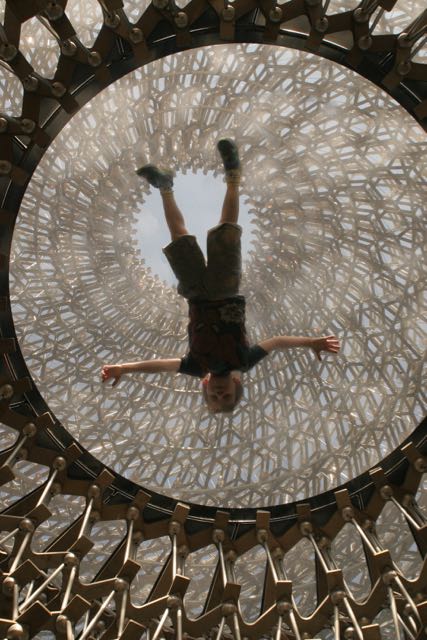A magazine where the digital world meets the real world.
On the web
- Home
- Browse by date
- Browse by topic
- Enter the maze
- Follow our blog
- Follow us on Twitter
- Resources for teachers
- Subscribe
In print
What is cs4fn?
- About us
- Contact us
- Partners
- Privacy and cookies
- Copyright and contributions
- Links to other fun sites
- Complete our questionnaire, give us feedback
Search:
The Hive at Kew
by Paul Curzon, Queen Mary University of London

Combine an understanding of science, with electronics skills and the creativity of an artist and you can get inspiring, memorable and fascinating experiences. That is what the Hive, an art instillation at Kew Gardens in London does. It is a massive sculpture linked to a subtle sound and light experience, surrounded by a wildflower meadow, but based on the work of scientists studying bees.
The Hive is a giant aluminium structure that represents a bee hive. Once inside you see it is covered with LED lights that flicker on and off apparently randomly. They aren't random though, they are controlled by a real bee hive elsewhere in the gardens. Each pulse of a light represents bees communicating in that real hive where the artist Wolfgang Buttress placed accelerometers. These are simple sensors like those in phones or a BBC micro:bit that sense movement. The sensitive ones in the bee hive pick up vibrations caused by bees communicating with each other The signals generated are used to control lights in the sculpture.
This is where the science comes in. The work was inspired by Martin Bencsik's team at Nottingham Trent University who in 2011 discovered a new kind of communication between bees using vibrations. Before bees are about to swarm, where a large part of the colony split off to create a new hive, they make a specific kind of vibration, as they prepare to leave. The scientists discovered this using the set up copied by Wolfgang Buttress, using accelerometers in bee hives to help them understand bee behaviour. Monitoring hives like this could help scientists understand the current decline of bees, not least because large numbers of bees die when they swarm to search for a new nest.
The Kew Hive has one last experience to surprise you. You can hear vibrations too. In the base of the Hive you can listen to the soundtrack through your teeth. Cover your ears and place a small coffee stirrer style stick between your teeth, and put the other end of the stick in to a slot. Suddenly you can hear the sounds of the bees and music. Vibrations are passing down the stick, through your teeth and bones of your jawbone to be picked up in a different way by your ears.
A clever use of simple electronics has taught scientists something new and created an amazing work of art.


